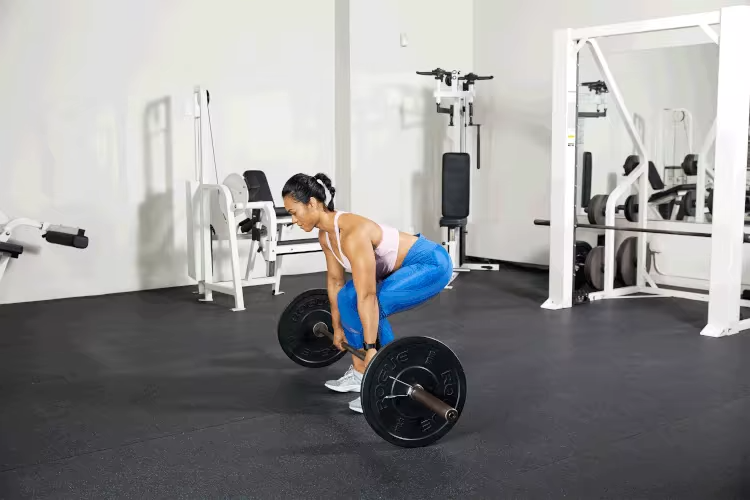A wonderful exercise for developing strong legs and butt is the deadlift. With the help of most of your body’s big muscle groups, you use your leg and hip muscles to predominantly move weight from the ground to your thighs during a deadlift. Although dumbbells can be used, the deadlift is typically executed using a fixed barbell or bar and plates. You shouldn’t disregard powerlifters’ specialty when doing general fitness training. Include deadlifts in your strength training regimen to increase muscular mass and functional fitness.
How to Perform a Deadlift
Select a lightweight barbell or two dumbbells.
- Grasp the bar just outside the line of your knees with an overhand or mixed grip.
- Position your feet shoulder-width apart (or not much more) with toes under the bar. Your feet point straight ahead, or they can angle out slightly. Heels should stay flat on the surface. As you lift and lower the bar, it will travel close to the shins and may even graze them. Maintain a neutral spine position.
- Engage your abdominal muscles.
- Slowly bring the weight down as far as you can while maintaining proper form, softening your knees, and keeping your back flat.
- Lift the bar by pushing upward with the legs from the knees. Breathe out on exertion. Be careful not to raise the hips first so the trunk moves forward and the back becomes rounded. Don’t try to haul the bar up with your arms. The arms stay extended under tension while gripping the bar as the legs push up. Think of the legs and shoulders moving upward in unison with the hips, the balancing point.
- The bar should almost graze the shins and rest around the thighs as you reach full height. Pull the shoulders back as much as possible without bending backward at Deadlifts: Proper Form, Variations, and Common Mistakes.
- Lower the bar toward the floor with a reverse motion ensuring a straight back.
- Repeat for your desired number of repetitions.
Benefits of Deadlifts
The deadlift uses the hamstrings (back of thigh), quadriceps (front of thigh), gluteals (butt), and lower back muscles (erector spinae). The stabilizer muscles of the core, abs, shoulders, and upper back also come into play.
Builds Muscle Mass
Deadlifts are highly regarded for building muscle mass, which is desirable for bodybuilders and people who want to prevent or reverse muscle loss due to aging.1 You can use deadlifts to build overall strength, core strength, and stability.
Boosts Metabolism
Your metabolism determines how many calories you burn at rest.2 Lean muscle speeds your metabolism. By increasing the amount of lean muscle in your body, you can help give your metabolism a boost. Since deadlifts work with some of the largest muscle groups in the body, they are a good choice for building a greater percentage of lean muscle in your body.
Builds Functional Fitness
The deadlift is one of the best exercises for mimicking the lifting you do throughout the day, so it is a functional exercise. Learning to deadlift with good form, you will be able to lift and carry items with less risk in daily life.
Other Variations of Deadlifts
You can do deadlift variations to suit your goals and fitness level. Several advanced variations are possible with alternative leg and grip positions.
As with all exercises, if you are new to deadlifting, lift only light weights or even a bar without any additional weight. Have a personal trainer coach you and give feedback on your form. Increase weight when you are performing it correctly at Deadlifts: Proper Form, Variations, and Common Mistakes.
Dumbbell Deadlifts
If you don’t have access to a barbell or the bar’s weight is too challenging, try a kettlebell or vertical dumbbell deadlift with a lighter weight. Grasp the object with both hands and hinge at the hips to lift it, as with a barbell. Alternatively, workout sandbags can be used for a variety of full-body exercises, including deadlifts.
Romanian Deadlifts
The main difference between Romanian deadlifts and regular deadlifts is that instead of starting the lift from a squat, Romanian deadlifts start the lift from a standing position. This variation works the posterior chain muscles, which include the muscles that run along the back side of your body, such as the glutes, hamstrings, and calves.1 You can also do the Romanian deadlift with offset feet, which may more closely mimic real-life situations in picking up and moving heavy objects at Deadlifts: Proper Form, Variations, and Common Mistakes.
Stiff-Leg Deadlift
In this version of deadlifts, you remain standing during the entire motion, keeping your legs stiff and your knees almost locked. Maintain a neutral spine and keep the bar close to your body as you bend forward and return to standing. The stiff leg deadlift activates the hamstrings and gluteus maximus more than standard or Romanian deadlifts.3
Suitcase Deadlift
This variation requires lifting weight on one side of the body at a time, using only one hand. Imagine the movement of picking up a suitcase. It is excellent for strengthening your core, as you engage those muscles to prevent your body from leaning over to the side with the weight.4 This movement requires bending as if to squat, as in a standard deadlift, rather than keeping straight legs at Deadlifts: Proper Form, Variations, and Common Mistakes.
Change Your Deadlift Grip
These are the possible grip types while performing deadlifts:
- The standard overhand grip has both hands with palms facing the body. If you can see the backs of both hands, that’s the overhand grip. This grip is suitable for lighter weights.
- The mixed grip has one hand grasping the bar with the palm under the bar (supinated) and the other with the palm over the bar (pronated). The mixed overhand-underhand grip is for heavier weights. This grip provides some reassurance that heavier weights will not slip from the hands.
The grip can be wider or narrower on the bar. A typical starting position is a grip perpendicular to the point of the shoulder with arms straight down. A slightly wider grip may suit some people, and a wide-grip deadlift is a valid variation. The standard grip utilizes the quadriceps (rather than the hip and back with the wide grip) and is more suitable for heavier lifts.
Deadlift Common Mistakes
Deadlifts have so many benefits, but doing them correctly is paramount. Injury from deadlifts could leave you unable to exercise while you recover, so it’s not worth taking risks. Avoid these errors so you can get the most out of this exercise with less risk of strain or injury.
Rounding Your Back or Shoulders
Keep your back straight with no rounding at the shoulders and spine. You should be hinging at the hip. Keep those hips down, butt out. Engage your core to support your straight back.
Lifting With Your Arms or Back
For beginners, the key to the lifting process is to lift with the legs and hips, not the arms, shoulders, or back—although their stabilizing role is important. Keep your arms straight throughout the deadlift. Bending your arms can strain your biceps.
Using Too Much Weight
When starting, practice with light weight until your form is satisfactory. A personal trainer or gym attendee can check you for the correct form. Practice in a mirror if necessary. You can add weight as your fitness increases, but it’s better to do so modestly so you don’t strain your muscles. As with all weightlifting exercises, proper footwear, like these best CrossFit shoes, is essential.
Partial Lifts
With a light weight, you can do repetitions in which you lower the bar to your shin or even floor and then straighten again without releasing your grip on the bar. This is not truly a deadlift repetition. It is better to practice a full lift, lower to the floor, and start again from a standing position.
Bar Too Far From Body
Sometimes when people perform deadlifts, they position the weight too far away from the body. The bar should travel close to the body for maximum lift efficiency and safety. It’s OK to skim the front of your legs as you lift and lower at Deadlifts: Proper Form, Variations, and Common Mistakes.
Safety and Precautions
The deadlift is an advanced weightlifting exercise. Talk to a healthcare provider to see if it is appropriate for you if you have any injuries or conditions affecting your legs, knees, ankles, hips, back, shoulders, or wrists. Be sure you receive appropriate coaching for the correct technique. Use light weights to start, and stop if you feel any pain. In pregnancy, it is best to use lighter weights, and you may wish to use the wider sumo stance. Women should consider wearing a high-neck sports bra for extra support.
Try Deadlifts
Incorporate deadlifts and similar moves into one of these popular workouts:

